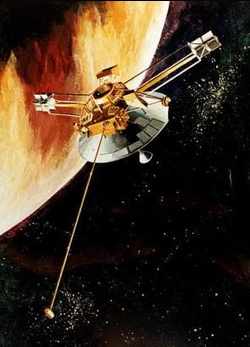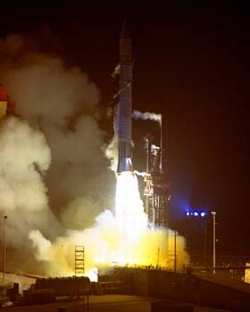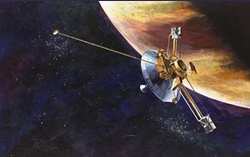Pioneer 10 Sends Last Signal Last Month
 After more than 30 years, it appears the venerable
Pioneer 10 spacecraft has sent its last signal to Earth.
Pioneer’s last, very weak signal was received on Jan. 22,
2003.
After more than 30 years, it appears the venerable
Pioneer 10 spacecraft has sent its last signal to Earth.
Pioneer’s last, very weak signal was received on Jan. 22,
2003.
NASA engineers report that Pioneer 10’s radioisotope power
source has decayed, and it may not have enough power to send
additional transmissions to Earth. NASA’s Deep Space Network
(DSN) did not detect a signal during the last contact attempt on
Feb. 7, 2003. The previous three contacts, including the Jan. 22
signal, were very faint, with no telemetry received. The last time
a Pioneer 10 contact returned telemetry data was April 27, 2002.
NASA has no additional contact attempts planned for Pioneer 10.
 “Pioneer 10 was a pioneer in the true sense
of the word. After it passed Mars on its long journey into deep
space, it was venturing into places where nothing built by humanity
had ever gone before,” said Dr. Colleen Hartman, director of
NASA’s Solar System Exploration Division, NASA Headquarters,
Washington. “It ranks among the most historic as well as the
most scientifically rich exploration missions ever
undertaken,” she said.
“Pioneer 10 was a pioneer in the true sense
of the word. After it passed Mars on its long journey into deep
space, it was venturing into places where nothing built by humanity
had ever gone before,” said Dr. Colleen Hartman, director of
NASA’s Solar System Exploration Division, NASA Headquarters,
Washington. “It ranks among the most historic as well as the
most scientifically rich exploration missions ever
undertaken,” she said.
“Originally designed for a 21-month mission, Pioneer 10
exceeded all expectations and lasted more than 30 years. It was a
workhorse that far exceeded its warranty, and I guess you could say
we got our money’s worth,” said Pioneer 10 Project
Manager, Dr. Larry Lasher of NASA Ames Research Center, located in
California’s Silicon Valley.
Pioneer 10 was built by TRW Inc., Redondo Beach, Calif., and was
launched on March 2, 1972 (below, right) on a three-stage
Atlas-Centaur rocket. Pioneer 10 reached a speed of 32,400 mph
needed for the flight to Jupiter, making it the fastest human-made
object to leave the Earth; fast enough to pass the moon in 11 hours
and to cross Mars’ orbit, about 50 million miles away, in
just 12 weeks.
On July 15, 1972, Pioneer 10 entered the asteroid belt, a
doughnut-shaped area that measures some 175 million miles wide and
50 million miles thick. The material in the belt travels at speeds
up to 45,000 mph and ranges in size from dust particles to rock
chunks as big as Alaska.
 Pioneer 10 was the first spacecraft to pass
through the asteroid belt, considered a spectacular achievement,
and then headed toward Jupiter. Accelerating to a speed of 82,000
mph, Pioneer 10 passed by Jupiter on December 3, 1973.
Pioneer 10 was the first spacecraft to pass
through the asteroid belt, considered a spectacular achievement,
and then headed toward Jupiter. Accelerating to a speed of 82,000
mph, Pioneer 10 passed by Jupiter on December 3, 1973.
The spacecraft was the first to make direct observations and
obtain close-up images of Jupiter. Pioneer 10 also charted the gas
giant’s intense radiation belts, located the planet's
magnetic field, and established that Jupiter is predominantly a
liquid planet. In 1983, Pioneer 10 became the first human-made
object to pass the orbit of Pluto, the most distant planet from the
sun.
Following its encounter with Jupiter, Pioneer 10 explored the
outer regions of the solar system, studying energetic particles
from the sun (solar wind), and cosmic rays entering our portion of
the Milky Way. The spacecraft continued to make valuable scientific
investigations in the outer regions of the solar system until its
science mission ended on March 31, 1997.
Since that time, Pioneer 10’s weak signal has been tracked
by the DSN as part of a new advanced concept study of communication
technology in support of NASA's future Interstellar Probe mission.
At last contact, Pioneer 10 was 7.6 billion miles from Earth, or 82
times the nominal distance between the sun and the Earth. A that
distance, it takes more than 11 hours and 20 minutes for the radio
signal, traveling at the speed of light, to reach the Earth.
“From Ames Research Center and the Pioneer Project, we
send our thanks to the many people at the Deep Space Network and
the Jet Propulsion Laboratory (JPL), who made it possible to hear
the spacecraft signal for this long,” said Pioneer 10 Flight
Director David Lozier, also of NASA Ames.
 Pioneer 10 explored Jupiter, traveled twice as far
as the most distant planet in our solar system, and as
Earth’s first emissary into space, is carrying a gold plaque
that describes what we look like, where we are and the date when
the mission began. Pioneer 10 will continue to coast silently as a
ghost ship through deep space into interstellar space, heading
generally for the red star Aldebaran, which forms the eye of the
constellation Taurus (The Bull). Aldebaran is about 68 light years
away. It will take Pioneer 10 more than 2 million years to reach
it. Its sister ship, Pioneer 11, ended its mission Sept. 30, 1995,
when the last transmission from the spacecraft was received.
Pioneer 10 explored Jupiter, traveled twice as far
as the most distant planet in our solar system, and as
Earth’s first emissary into space, is carrying a gold plaque
that describes what we look like, where we are and the date when
the mission began. Pioneer 10 will continue to coast silently as a
ghost ship through deep space into interstellar space, heading
generally for the red star Aldebaran, which forms the eye of the
constellation Taurus (The Bull). Aldebaran is about 68 light years
away. It will take Pioneer 10 more than 2 million years to reach
it. Its sister ship, Pioneer 11, ended its mission Sept. 30, 1995,
when the last transmission from the spacecraft was received.
 Aero-News: Quote of the Day (12.07.25)
Aero-News: Quote of the Day (12.07.25) ANN's Daily Aero-Linx (12.07.25)
ANN's Daily Aero-Linx (12.07.25) NTSB Final Report: Lafferty Jack Sea Rey
NTSB Final Report: Lafferty Jack Sea Rey Classic Aero-TV: The B29 SuperFortress Doc - History in Flight
Classic Aero-TV: The B29 SuperFortress Doc - History in Flight Airborne 12.08.25: Samaritans Purse Hijack, FAA Med Relief, China Rocket Fail
Airborne 12.08.25: Samaritans Purse Hijack, FAA Med Relief, China Rocket Fail






